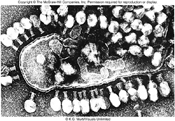Unit 1
Objectives
This unit introduces you to the world of microbiology. You will study the microscope, the tool used to observe the world of microbes. Also examined will be the differences between the types of cells found in the microbial world as well as introduction to viruses.
1. Introduction and History
- Define microbiology and the specific branches.
- Microbes are ubiquitous and play a crucial role in the biosphere, through photosynthesis and decomposition. They can be genetically modified to help the environment by the process bioremediation.
- Although the majority of microorganisms are not pathogenic, infectious diseases caused by microorganisms are still a common cause of death.
- Identify key significant events and its contributor in the development of modern day microbiology.
- Discuss the purpose and components of the scientific method.
- Identify the taxonomic groupings in the Linnaean system and their relationship to one another. Discuss the significance of binomial nomenclature.
- Describe the distinguishing characteristics of the five kingdoms and give examples of members of each. Distinguish between the Whittaker and Woese-Fox systems of classification.
2. Chemistry
- Discuss the macromolecules and how they fit into the scheme of life.
- Be able to define acidity, alkalinity and the pH scale.
3. Microscopy
- Identify the required parts of the microscope and state their functions.
- Discuss the properties of light and how they relate to microscopic images.
- Correctly use terminology associated to microscopy.
- Compare the formation of images by light microscopes and by the electron microscope including the limits of resolution for each.
- Discuss the advantages and disadvantages of using special microscopes.
4. Procaryotic organisms
- There are two types of cellular microorganisms (prokaryotes and eukaryotes). All prokaryotes are microorganisms, but only some eukaryotes are microorganisms. Eukaryotes, which contain nuclei, arose from prokaryotes, which do not contain nuclei.
- Identify the three basic forms of bacteria and the colonial arrangements possible for each basic bacterial type.
- Name the structures found in a typical bacterial cell and the function of each.
- Describe the chemical similarities and differences in the cell walls of gram positive and gram negative bacteria.
- Describe the steps in the Gram stain and the reason for the difference in appearance between gram positive and gram negative organisms.
- Compare/contrast true bacteria, Rickettsia, Chlamydia, and viruses.
5. Eucaryotic organisms
- Compare and contrast prokaryotic and eucaryotic cells.
- Name the structures found in a typical eucaryotic cell and the function of each.
6. Viruses
- Viruses are microorganisms that are noncellular; they are much simpler than cells. Compare/contrast viruses with chemicals and with living organisms.
- Discuss the chemical composition and structure of a virion.
- Sequence the following stages of viral replication and describe what happens in each: adsorption, release, penetration, replication, assembly, and maturation.
- Compare the following virus-host relationships: lytic (acute) infection, lysogenic (latent) infection), oncogenic (tumor).
- Explain what is meant by inclusion body. Define the following terms used in virus identification:
- Cytopathic effect (CPE)
- Compliment fixation
- Plaque formation
Readings: Talaro: Chapters 1, 3 (microscopy), 4, 5, 6
Laboratory Activities and Objectives:
- Explore the ubiquity of microorganisms.
- Complete Microscopy Module. Demonstrate proper use and care of the microscope.
- Observe the macroscopic and microscopic morphology of bacteria on prepared slides. Identify their shape and arrangement.
- Identify capsules, flagella arrangements and spore locations on prepared slides.
© 2015 George Wawrzyniak. All Rights Reserved.
|




